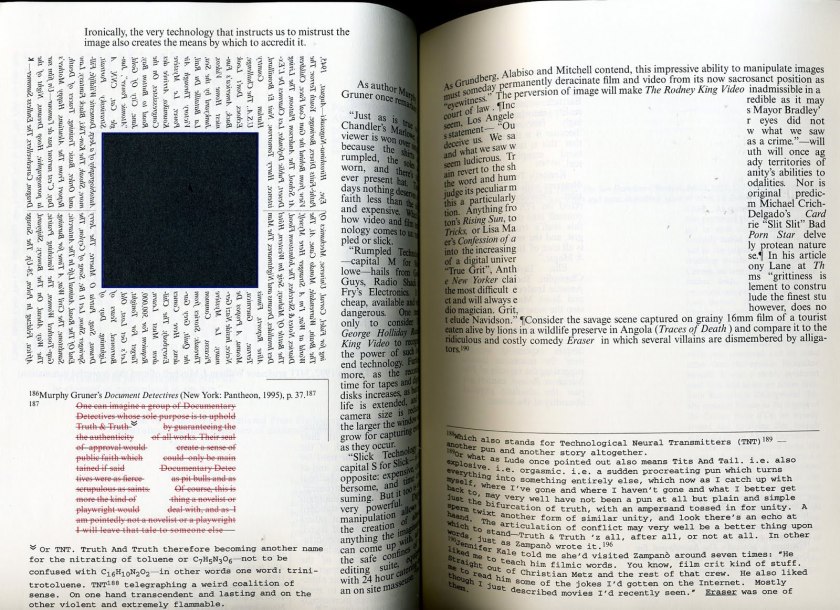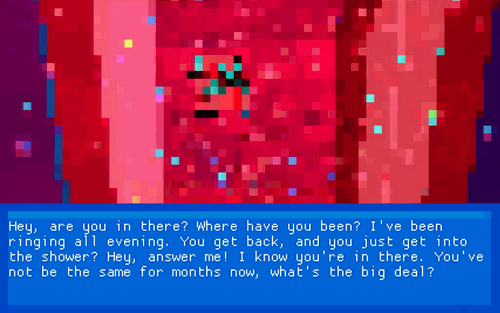
In late November last year, I had the pleasure of attending the Irish Association for American Studies Postgraduate Symposium. The breadth of topics covered by presenters was incredibly wide – everything from the roots of contemporary identity politics in the Riot Girl movement, to the ecocriticism of Peter Benchley’s Jaws, to a comparative study of the Pentagon Papers and Wikileaks – and I think this speaks volumes to the strength of American Studies scholarship in Ireland at the moment. However, one paper in particular stood out to me, and that was Sean Travers’ exploration of perpetrator trauma in contemporary American fiction, film, television, and video games. Given the inundation of questions she received after her talk, especially on the subject of video games, I clearly wasn’t the only one who found her research thought provoking. Seeing as I’m currently doing some research on trauma narratives myself, I thought now would be a good time to revisit Travers’ paper, before adding some of my own thoughts on the subject.
The crux of Travers’ argument is that postmodern developments in narrative technique have effected a change in the subject position of the reader/audience from one of passive reception to active participant, and that this shift has opened up new opportunities to explore the subject of perpetrator trauma. According to Travers, the starting point for this shift is located in Jean-François Lyotard’s assertion that postmodernity is defined by an increasingly widespread disbelief in metanarratives, which led to a change in focus for literature from singular truths to multiple truths, objective narration to subjective narration, and passive reading to active participation. The work of people such as Roman Ingarden and Wolfgang Iser on the interaction between reader and text is also related to this process, leading to the development of reader response and reception theory. Alongside these developments in narrative technique, Cathy Caruth’s work on trauma theory led to the the idea that trauma could be transmitted from writer to reader via literature through structural techniques that imitate the symptoms of PTSD such as delayed reception, flashback, and repetition. Travers pointed to the work of writers such as John Barth and Donald Barthelme as examples of postmodern texts featuring mutually exclusive narrative possibilities, and then to texts such as Tim O’Brien’s In the Lake of the Woods, David Lynch’s Twin Peaks, and Mark Z. Danielewski’s House of Leaves as illustrative of the way this technique of mutual exclusivity can be adapted to represent the aporias of Caruthian trauma. Travers closed her presentation by suggesting that, because of a unique emphasis on audience participation, video games as a medium are particularly suited to this kind of trauma exploration. This is especially true of perpetrator trauma, where the systems of player choice which occurs in games such as Irrational’s BioShock, or Telltale’s The Walking Dead and The Wolf Among Us series can be used to force a player into confrontation with the consequences of their actions.

I agree for the most part with Travers argument, and hopefully the belatedness of this review hasn’t caused me to misrepresent her findings. However, I’d like to make two minor (if not so brief) points. Firstly, as regards Twin Peaks, I think that it’s necessary to make a distinction between the depiction of trauma in the television series and the later film, Fire Walk with Me. The point of focalisation in the series is FBI Special Agent Dale Cooper, which loosely frames Twin Peaks as a detective show. As such, while the show does probe into the trauma of its characters, this is always from an outside perspective with a view to mediation. While he’s ostensibly there to right the wrongs of the past and confront the metaphysical evil within, in time Cooper becomes a kind of surrogate therapist for the town, there to help its inhabitants learn to live with their guilt and shame. This is especially true of the conclusion to the Laura Palmer storyline (episode 16), where Cooper absolves Leland Palmer of his sins, and later, when challenged by Harry over his metaphysical explanation of events responds with the truly absurd line: “Harry, is it easier to believe a man would rape and kill his own daughter? Any more comforting?”. The idea of comfort is exactly what’s at question here – rather than deal with the harrowing emotional implications unleashed by these revelations, the series escapes into mythology, where all this can be safely framed within a much broader and impersonal Manichaean struggle. While I agree with Roger Luckhurst’s argument that the show depicts expressions of boundless grief so extreme that they push past melodrama, back into the realm of reality (200), the show’s tonal unevenness and unwillingness to deal seriously with the emotional consequences of its own plot make it difficult to argue strongly for it as a trauma narrative (though this negligence may itself tell us something about the difficulties of discussing trauma).

Fire Walk with Me, however, I have no such qualms about. While the film starts out with a familiar detective story framing, this opening section only serves to parody the kind of genre hermeneutics employed by the series. Instead of Twin Peaks, where a serene exterior conceals the dark underbelly, Agent Baker is sent to Trout Creek, a nightmare reflection of the series where the rank, base, corruption of all is flagrant. This is not a town for a dashing outsider to come to and nurse back to health; whatever systemic evil there is in the world has taken root far too long ago. The healing potential offered by the investigative branch of federal government here meets an appropriately surrealist-comic end when Baker finds a clue and abruptly disappears himself, thereby offering a firm rebuttal to the notion that contrived heroism is any kind of a real balm to the traumatised individual or community.
From there on, the film engages directly with everything the series was only willing to approach through abstraction. The final days of Laura Palmer, her abuse at the hands of her father, and her tragic descent into self destruction are all dealt with in excruciating detail, and all through Laura’s own traumatised point of view. It’s this shift in focalization that redeems Twin Peaks as a trauma narrative. Because the narrative is subjective-experiential, instead of the show’s objective-investigative framing, it can engage with the kind of Caruthian expressionist techniques set out by Travers above. Similarly, this framing allows the film to deal with the perpetrator trauma of Leland in a much more serious way than the series’ rush to absolve. Though the film still reaches the same conclusion, and Leland seems to be forgiven, this is to be understood as a transcendent act of unimaginable divine grace on Laura’s part (as symbolised by the final reappearance of the angel), and can be read as such only because we are made to fully understand exactly how awful the sins she is asked to forgive are.

The second point I’d like to make concerns the difference between “ordinary” trauma narratives and perpetrator narratives in video games. While critics such as Alan Gibbs may quite rightly call attention to the problems imposed by any rote binary opposition between these two types of narratives (167), for the moment I’d like to maintain this distinction because it is useful in illuminating the types of mechanics employed by games in their depiction of such genres. Travers is quite right to say that games excel at explorations of perpetrator trauma, and this is tied to a industry-wide predilection for power fantasies. When the most basic mechanic in the majority of games is to pull the trigger of a gun, and the goal of most games is to perform mass murder which has been framed in such a way so as not to bother the player too much with the consequences of their actions (famously termed “ludonarrative dissonance” by Clint Hocking), the reframing as perpetrator trauma actually requires relatively little change to the overall design. A game such as BioShock presents the player with a way to express themselves morally, and then at the denouement strips that choice away, or otherwise undermines the ethical standing and control over events you felt you had. To Travers’ above list, I’d add Modern Warfare 2‘s “no Russian” segment and Spec Ops: The Line as examples of games that pull off this trick relatively successfully.

However, for me, what’s far more interesting is games that attempt to explore the victimhood of trauma. While such an approach may now be bordering on cliche in literature (Gibbs singles out the work of Jonathan Safran Foer as a particularly egregious example, 148-159), especially when compared to the relative rarity of perpetrator traumas, the aforementioned tendency of games as a medium towards infliction of violence means that slow and uncomfortable meditations on the effect of that violence on the individual are far less frequent and by necessity more avant-garde in their mechanics. For instance, Porpentine’s Howling Dogs explores the emotional trauma of her hormone-replacement therapy by slowly constricting the space available for the player to explore. In a similar vein, Dreamfeel’s Curtain forces the player to repeatedly relive moments from an abusive relationship while frantically searching for an escape. A possible bridge between the experimental design of these games and the perpetrator trauma-focused games above is Richard Cowley’s I Cheated On You, a game where the player is made to repeatedly lie to their partner about their infidelity. As Aidan Wall claims, “I Cheated On You‘s story was easy to identify with as an observer, but it was in the ludic action of engaging with its mechanics that I became most aware of the cowardly processes I myself utilise to avoid and forego facing up to my guilt. It made me aware of my complicity” (148).
A game very close to my own heart which deals with trauma is Cardboard Computer’s Kentucky Route Zero. KRZ is an episodic, narrative-led point and click adventure game which draws heavily from Southern Gothic and Magic Realist fiction, as well as experimental theatre and film techniques. It certainly owes more than a passing debt to Twin Peaks in its realisation of abstract, surreal universes located deep in the American woodlands, and someone like FWWM‘s Carl Rodd would fit in well with KRZ’s catalogue of the disenfranchised. However, all this is just (admittedly gorgeous) set dressing for the issue at the heart of KRZ: trauma. This trauma takes a multitude of forms, but despite the abstract setting (or perhaps because of it), the problems of the characters always feel incredibly grounded in materiality. They deal with alcoholism, unemployment, debt, lack of health insurance, disruption of community, and loss of family. The player’s only way to respond to these kinds of losses is to talk to other characters and engage in social bonding. While you are presented with dialogue options, instead of allowing you to assert yourself in terms of moral superiority, all you can do is choose how to orientate yourself to the grief which imposes itself so insistently. Do you wallow in self pity? Or crack a joke? Or share a memory from your past that’s painful, in the hope that it might lighten the load of someone else. As Cara Ellison points out, KRZ is a game where the unsteady steady the unsteady. Much like Trout Creek, the Zero is no place for heroism, the problems here are ingrained too deeply, too systemic. Instead, as Ellison suggests, “it asks no questions, and gives no answers. The problems are part of the landscape of being. They are part of the experience of play. You can only go through them, you cannot run away from them. You can merely choose what you say in response”.

Works Cited
Cardboard Computer. Kentucky Route Zero. 2013-2016.
Crowley, Richard. I Cheated on You. 2013.
Dreamfeel. Curtain. 2014.
Ellison, Cara. “The Unsteady Steadying the Unsteady”. caraellison.co.uk. 08/11/2016.
Frost, Mark and Lynch, David, creators. Twin Peaks. Lynch/Frost Productions. 1991.
Gibbs, Alan. Contemporary American Trauma Narratives. Edinborough UP. 2014.
Hocking, Clint. “Ludonarrative Dissonance in Bioshock”. clicknothing.typepad.com. 07/10/2007.
Luckhurst, Roger. The Trauma Question. Routledge. 2008.
Porpentine. Howling Dogs. 2012.
Travers, Sean. ‘Who is the villain?: Perpetrator trauma and the role of the reader in American fiction’. University College Cork. 26/11/2016.
Twin Peaks: Fire Walk with Me. David Lynch, director. CIBY Pictures. 1992.
Wall, Aidan. “Complicit and Guilty”. Critical Hits: An Indie Gaming Anthology ed. Zoe Jellicoe. pp.140-152. 2016.
One thought on “Sean Travers: ‘Who is the villain?; Perpetrator trauma and the role of the reader in American fiction’”